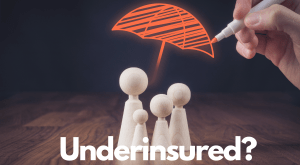As the cost-of-living crisis takes hold, so does the need to cut costs. But just as home and business owners dissect their spending, they need to carefully consider the associated risks. Take insurance as an example, underinsurance is a real risk.
According to Aviva in their Risk Insight Report, one-fifth of businesses surveyed reduced or considered reducing cover in the last year.
According to Prosura CEO Jon Newall, underinsurance is a real risk.
Jon comments: “Naturally, customers both business and lifestyle, want to pay less, but this cannot be at the detriment of the right cover. Honest and open conversations with your broker will help you to get the best deal. Whilst this may not always be the cheapest, it will be with cover that delivers the protection you actually need.”
The true value
“Problems occur when the true value of assets or potential risks are not disclosed – either accidentally or intentionally. This may deliver a reduced premium, but the truth is that this could result in underinsurance, and we know that underinsurance is a real risk, if not a critical one!
“It’s our job as brokers to get to know our customers. We need to understand what they need and what their risks are. It is equally important that we educate them on their obligations, risk factors, policy exclusions and conditions, such as the Clause of Average.
“This enables us to recommend adequate protection while helping the client to make an informed decision about their policy. Not only does this result in sharing the best advice, but it can also prevent underinsurance.”
Underinsurance is a real risk
So, what is underinsurance and is it a big issue?
Underinsurance is when “a consumer isn’t insured for the full amount needed”, according to the FCA. Providing some context, in property terms, the sum insured for the property is less than its value.
Underinsurance is a real risk, it is one of the biggest issues facing the industry and impacts both business and lifestyle insurance.
According to Insurance Age, Aviva’s Risk Insights Report estimates that as many as 50% of the UK’s businesses are underinsured.
Recent data put light on the issues. Commercial valuers, Barrett Corp Harrington, carried out 4,813 property surveys between January and July 2022. Over 75% were found to be underinsured, with a recommendation that values, on average, should be increased by 53%*.
According to a recent article in This Is Money, four in five homes do not have enough building or contents cover.
Causes of underinsurance
There are lots of reasons for underinsurance, both for those investing in business insurance and lifestyle insurance.
Attitudes towards risk vary. As brokers, we work hard to recognise what influences attitudes to risk. As an example, some individuals may see insurance as a cost and not a benefit. It is therefore important for insurance brokers to demonstrate the true value of insurance.
Covid pressed pause on ‘business as usual’. Put simply, individuals did not conduct valuations during this time, or they happened less frequently. So, in many instances the true value of an asset is not known.
Just as insurance needs change, values change year on year. As an example, house prices may be falling but inflation means that costs associated with rebuilding a property, such as materials and labour, are growing.
This is evidenced by Chaucer. In March 2023, they detailed rebuild costs at 10.4% higher than 12 months ago, as noted by the UK Construction Material Price Index.
Home improvements, especially during covid, may have impacted values too – whether this is from the rise in home offices or the investment made in indoor and outdoor spaces.
Including all assets is often a stumbling block. ABI details carpets, furniture, soft furnishings, collectables and white goods as assets most forgotten about. Meanwhile, Aviva reinforces the need for businesses to consider valuations of machinery, equipment and stock.
In addition, the true value of items is often overlooked. Take Rolex watches, which regularly increase in value. Not only could this mean contents are underinsured, but such items may also exceed single-item limits.**
So, what does being underinsured mean?
Being underinsured may mean that an insurer will not pay out a claim in full and the policyholder is left to cover the shortfall.
Jon explains: “Underinsurance should not be overlooked. Policyholders could be out of pocket if the worst happens, and they have to make a claim. If underinsurance is identified by the insurer, they will reduce their payout; this has significant implications.”
Understanding the Condition of Average Clause
If you make a claim and are underinsured, your insurer can apply the Average Clause. The Average Clause means that they can reduce the amount of money that they payout to you.
Jon adds: “If a policyholder insures their home for £200,000 when a rebuild cost is £400,000, they are underinsured by 50%.
“If a later claim is made for £50,000 due to a fire, as an example, your insurer will only payout 50% of the claim. This is even though your home is insured for £200,000. They can reduce their payment to you by the same proportion as the undervalue.
“In short, if you are underinsured by 50%, you may only receive 50% of any claim made, and need to be prepared to pay the shortfall.”
The Average Clause, also known as ‘The Condition of Average’, features in many policy documents (although exclusions do apply). It is not a new clause. It has been around for over 300 years!
The clause was developed to prevent policyholders from undervaluing assets, to reduce their premiums (or to get an insurer to agree to offer terms) and encourages risks and values to be detailed fairly and accurately.
Working together to find the real value
Underinsurance is a real risk. But, steps can be taken to prevent underinsurance, including:
- Work with an insurance broker. Have honest and open conversations with your insurance broker. They will help you to understand the importance of true values and to identify and understand your risks. They will also be clear on your obligations, detailing everything that you need to know so that you can make an informed decision about your policy and the required investment.
- Check your documentation for the Condition of Average Clause, which does feature in the majority of policies (although exclusions do apply). Understand what the Condition of Average Clause means. Make sure you know what the implications are should you need to make a claim.
- Know the true value of your assets. As an example, ABI features a rebuild calculator that could help detail changes to your property within the current climate. ABI Public Rebuild Calculator (bcis.co.uk)
- Revalue your assets regularly.
- Know your assets. What could you be forgetting to include in your policy that could put you at risk.
- Be aware of how much ‘things’ cost. It’s surprising how quickly we accumulate hidden treasures!
*The Broker Network – Underinsurance Webinar
** Education and client conversations key to reducing underinsurance in the HNW space – Insurance Age
